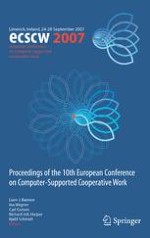The emergence and widespread use of personal computers and network technologies have seen the development of interest in the use of computers to support cooperative work. This volume presents the proceedings of the tenth European conference on Computer Supported Cooperative Work (CSCW). This is a multidisciplinary area that embraces the development of new technologies grounded in actual cooperative practices.
These proceedings contain a collection of papers addressing novel interaction technologies for CSCW systems, new models and architectures for groupware systems, studies of communication and coordination among mobile actors, studies of cooperative work in complex settings, studies of groupware systems in actual use in real-world settings, and theories and techniques to support the development of cooperative applications. The papers present emerging technologies alongside new methods and approaches to the development of this important class of applications.
